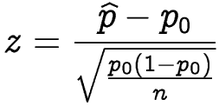R: One Proportion
An economics professor wishes to prove the hypothesis that over 60% of the freshman students enrolled at Dallas University own a credit card. He randomly samples 64 freshman students and finds that 47 have credit cards. With this information:
1. We will begin by defining the null and alternative hypthesis.
Ho: p = 0.6
Ha: p > 0.6
2. Next, in R, will define our variables and check the conditions need for inference.
> p.hat = 47/64 # calculate sample proportion
> p.hat
[1] 0.734375
>
> p.null = .60 # define null proportion
> n = 64 # define sample size
>
> # Check conditions for inference
> n*p.null
[1] 38.4
> n*(1 - p.null)
[1] 25.6
Conclusion: n*phat and n*qhat are both greater than 10. Therefore, we can proceed with our inference calculations.
3. Next, we will calculate our test statistic for this problem using the following formula.

> # Calculate test statistic
> z = (p.hat - p.null)/sqrt(p.null*(1 - p.null)/n)
> z
[1] 2.194335
4. Finally, this is a right-sided test, so we will use the following R code to find the p-value associated with a z of 2.194.
> # Right sided test, so calculate the area to the right
> p.value = pnorm(z, lower.tail=FALSE)
> p.value
[1] 0.01410568
Conclusion: Based on our analysis, we calculated a p-value of 0.014. Therefore, we reject the null hypothesis as 0.014 is less than 0.05. The data supports the claim that over 60% of the freshman students enrolled at Dallas University own a credit card.
Solution - part b
1. To calculate a 99% confidence interval, first start by completing steps #1 - #2 above. We will be using the following formula to calculate our confidence interval.

2. Once steps #1 - #2 from above are completed, we can then calculate z*, the standard error, and the margin of error as shown below:
> # Calculate z* for 90% confidence interval
> z.star = qnorm(0.95)
> z.star
[1] 1.644854
>
> # Calculate the standard error
> se = sqrt(p.hat*(1 - p.hat)/n)
>
> # Calculate the margin of error
> me = z.star*(se)
> me
[1] 0.09080937
3. Now that the margin of error has been calculated. We can simply calculate the lower an upper limits of our 99% confidence interval.
> # calculate the lower limit
> p.hat - me
[1] 0.6435656
>
> # calculate the upper limit
> p.hat + me
[1] 0.8251844
Conclusion: One can be 90 percent confident that the the proportion of freshman at Dallas University who own a credit card is between 0.644 and 0.825.

This work is licensed under a Creative Commons Attribution-NonCommercial-ShareAlike 4.0 International License.
